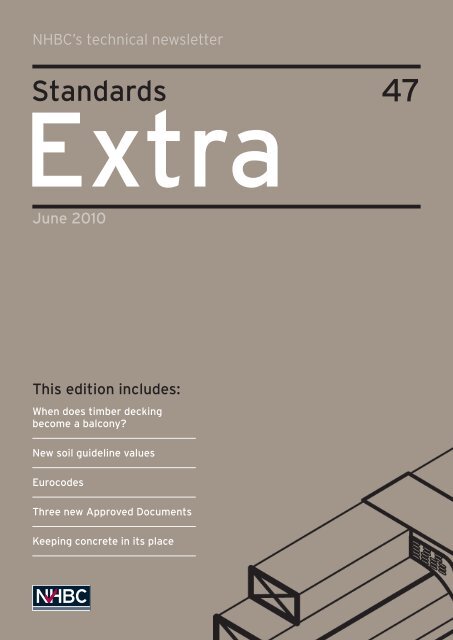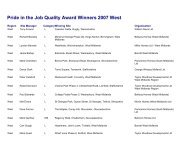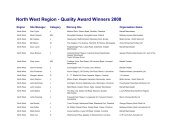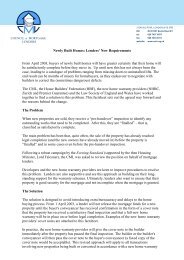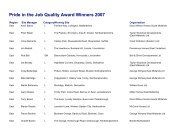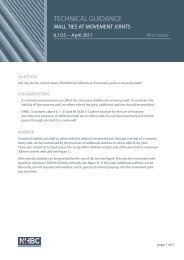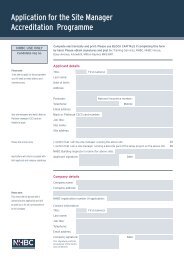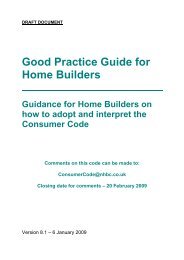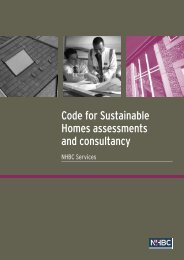June 2010 - NHBC Home
June 2010 - NHBC Home
June 2010 - NHBC Home
You also want an ePaper? Increase the reach of your titles
YUMPU automatically turns print PDFs into web optimized ePapers that Google loves.
<strong>NHBC</strong>’s technical newsletter<br />
Standards<br />
47<br />
Extra<br />
<strong>June</strong> <strong>2010</strong><br />
This edition includes:<br />
When does timber decking<br />
become a balcony?<br />
New soil guideline values<br />
Eurocodes<br />
Three new Approved Documents<br />
Keeping concrete in its place
Standards<br />
Extra<br />
CONTENTS<br />
1<br />
Balconies/raised<br />
timber decking<br />
2<br />
Glassfibre reinforced<br />
concrete<br />
3<br />
Eurocodes<br />
4<br />
Plasterboard<br />
cracking<br />
5<br />
New ADs<br />
When does timber<br />
decking become a<br />
balcony?<br />
In response to some recent enquiries, it seems that<br />
clarification is required on when timber can be used for the<br />
primary structure of raised timber decking and why it’s not<br />
permitted for balconies.<br />
Raised timber decking is dealt with in Chapter 9.2 of the<br />
Standards, whereas ‘Flat roofs and balconies’ are dealt with<br />
in Chapter 7.1.<br />
6<br />
B/Regs in Scotland<br />
8<br />
Seals and sealants<br />
8<br />
MCS and BBA certs<br />
for renewables<br />
9<br />
Soil guideline values<br />
10<br />
Clean cover systems<br />
11<br />
Keeping concrete in<br />
its place<br />
12<br />
Questions and<br />
Answers<br />
Raised timber decking<br />
Where any part of the decking is going<br />
to be more than 600mm above ground<br />
level the design and construction<br />
should be carried out in accordance<br />
with the guidance published by the<br />
Timber Decking Association (TDA).<br />
Their guidance does allow timber to be<br />
used provided it is correctly detailed<br />
and, where required, preservative<br />
treated. No part of the decking should<br />
be more than a storey height (e.g.<br />
2.40m) above ground level, and access<br />
ACTION<br />
to the decking comes from rooms on<br />
the ground floor.<br />
Balconies<br />
A balcony is a structure that provides<br />
an external area at first floor level or<br />
above. As such, and resulting from<br />
previous problems, <strong>NHBC</strong> considers<br />
that the use of timber, as the primary<br />
structure, is not appropriate.<br />
If in doubt, please refer to <strong>NHBC</strong><br />
Standards and Technical for further<br />
advice technical@nhbc.co.uk.<br />
If you are going to build either raised timber decking or an external<br />
balcony into your design please ensure that you use the correct<br />
materials. Particularly note that timber is not permitted as the<br />
primary structure in balcony construction.<br />
2
Issue 47<br />
<strong>June</strong> <strong>2010</strong><br />
Glassfibre Reinforced Concrete (GRC)<br />
GRC was first introduced in the early 1970s and is now used on some of the world’s largest<br />
and most prestigious building projects. In the UK, use of the material by house builders and<br />
developers is growing, both as a cladding solution and as a lightweight and durable alternative<br />
to traditional cast stone dressings.<br />
It is essential that GRC is correctly<br />
designed and manufactured for its<br />
intended purpose with appropriate<br />
quality control procedures in place.<br />
GRC is a cement-based composite,<br />
reinforced with special alkali resistant<br />
glass fibres, which are blended<br />
throughout the concrete matrix to<br />
give a material which displays a high<br />
resistance to tensile, bending and<br />
impact forces.<br />
GRC products may typically be only<br />
12-15mm thick, formed using thin wall<br />
casting or spraying techniques. The<br />
weight of GRC products is considerably<br />
less that than their conventional<br />
counterparts which helps with handling<br />
and installation. The nature of the<br />
material provides good resistance to<br />
damage at edges and corners.<br />
Traditional concrete is classified by<br />
its compressive strength (i.e. C40),<br />
GRC is classified by reference to<br />
its characteristic flexural strength<br />
(termed in the industry as Modulus<br />
of Rupture or MOR). For convenience<br />
of specification, GRC is graded into<br />
three categories, Grade 8, Grade 10,<br />
and Grade 18, each grade representing<br />
numerically the characteristic MOR<br />
value. Correct GRC manufacture<br />
requires that a regular testing regime<br />
is operated to measure and record<br />
MOR values (and other parameters)<br />
on a continuous basis.<br />
GRC in the UK will typically be<br />
manufactured in accordance with the<br />
best practices developed in Europe,<br />
America, Asia and Australasia over<br />
the last forty years. The International<br />
Glass Reinforced Concrete Association<br />
‘Specification for the manufacture,<br />
curing and testing of GRC products,<br />
Third Edition – March <strong>2010</strong>’ is an<br />
important reference for ensuring good<br />
quality GRC. This is consistent with,<br />
and refers to, national standards BS<br />
EN 1169 and BS EN 1170: 1998 parts<br />
1-7. A copy of the specification may<br />
be downloaded from the websites<br />
ACTION<br />
of the GRCA (http://www.grca.org.<br />
uk/technical/downloads.asp) or the<br />
Concrete Society.<br />
To ensure satisfactory in-service<br />
performance products must be<br />
designed to ensure adequate strength<br />
and appropriate fixing. The test data<br />
obtained from regular test results of a<br />
manufacturer is essential in validating<br />
the values used in design. This is<br />
particularly important for built-in items<br />
such as heads and band courses or the<br />
larger cladding panels which may be<br />
formed in GRC.<br />
When selecting a GRC product the user<br />
must ensure that design will be carried<br />
out in accordance with the relevant<br />
national standards for any intended<br />
profile or panel form, including the<br />
design of the fixing systems used to<br />
support or restrain GRC items. It is<br />
equally important to ensure that the<br />
manufacturer has access to both the<br />
facilities and procedures to carry out<br />
the testing required in the manufacture<br />
of GRC, or alternatively has in place<br />
arrangements for third party testing.<br />
The Glass Reinforced Concrete<br />
Association operates an ‘Approved<br />
Manufacturers Scheme’ whereby<br />
participating companies have<br />
demonstrated to the Association<br />
they have the procedures, plant and<br />
equipment to comply with the required<br />
specifications and standards. For<br />
further details about the GRCA and<br />
its Approved Manufacturers Scheme<br />
please visit www.grca.org.uk<br />
If you are proposing to use GRC products make sure they have been<br />
designed and manufactured in accordance with recognised standards<br />
and that the manufacturer is a member of the GRCA scheme.<br />
3
Standards<br />
Extra<br />
Eurocodes<br />
The Eurocodes are here and conflicting BS Codes have now been withdrawn.<br />
Eurocodes have become the national<br />
standards for structural design<br />
Structural Engineers in Europe are<br />
facing the greatest ever change in<br />
design codes and standards as the ten<br />
Eurocodes for structural design are<br />
implemented. In the UK all 58 Parts<br />
together with their National Annexes<br />
are published and many familiar British<br />
Standards have been withdrawn. Under<br />
an agreement between the European<br />
standardisation bodies conflicting<br />
national structural design standards<br />
had to be withdrawn by 31 March <strong>2010</strong>.<br />
The Eurocodes are published by BSI as<br />
BS EN 1990 to BS EN 1999 and they are<br />
now our national standards.<br />
When is the changeover to the new<br />
standards?<br />
There is no fixed date and it will be<br />
a matter of choice for designers and<br />
their clients. However, the adoption<br />
of Eurocodes will initially be driven by<br />
EU directives on public procurement<br />
enacted in the UK as the Public<br />
Contracts Regulations 2006. These<br />
Regulations will require most UK<br />
public sector organisations, utilities<br />
and product manufacturers to adopt<br />
Eurocodes as the preferred basis<br />
for defining technical specifications<br />
and designs. BSI will no longer be<br />
maintaining or updating the old British<br />
Standards, which are expected to fade<br />
from common use over the next few<br />
years. Reference to the Eurocodes will<br />
be updated as the Building Regulations<br />
Approved Documents are revised. In the<br />
case of Approved Documents A and C,<br />
the next periodic review has started and<br />
new versions are expected in 2013.<br />
In a letter to Building Control Bodies<br />
(BCBs), which can be found at http://<br />
www.communities.gov.uk/documents/<br />
planningandbuilding/pdf/1454859.pdf,<br />
the Department for Communities and<br />
Local Government has stated; “When<br />
assessing compliance with the Building<br />
Regulations, BCBs should continue to<br />
consider the appropriate use of relevant<br />
standards on a case by case basis.<br />
BCBs will need to be aware of the risk<br />
of designs inappropriately mixing new<br />
design standards based on the BS ENs<br />
and withdrawn BS design standards.”<br />
To help you meet changing design<br />
requirements, <strong>NHBC</strong> Building Control can<br />
accept designs to either the old British<br />
or new European codes to support<br />
proposals to satisfy Building Control<br />
and <strong>NHBC</strong> Buildmark submissions, but<br />
not a combination of both. Whether<br />
using the old or new codes, designers<br />
should satisfy themselves, and <strong>NHBC</strong><br />
Building Control, that the designs are<br />
still relevant to the particular design<br />
requirements of each project.<br />
For further information visit<br />
www.nhbc.co.uk/bc<br />
ACTION<br />
European codes and standards<br />
on site<br />
In recent years European product<br />
standards have replaced many familiar<br />
BS standards. The new standards<br />
are more performance based, which<br />
provides designers with greater choice<br />
and scope for innovation. Similarly, the<br />
new design standards also offer greater<br />
scope for innovation. This means that<br />
project specification drawings and<br />
details will often need to state the<br />
required performance characteristics<br />
(e.g. strength, density, fire resistance,<br />
thermal conductivity, water absorption)<br />
and on site it will become more<br />
important to check that the products<br />
used are the correct ones with the<br />
required performance characteristics.<br />
Where products bear the CE marking,<br />
the required performance values, levels<br />
or classes will be available on a label,<br />
on the packaging or in accompanying<br />
documentation.<br />
With the introduction of the Eurocodes as the new National Standards<br />
and the withdrawal of the old British Standards, designers will need to<br />
satisfy themselves and <strong>NHBC</strong> Building Control that the appropriate use<br />
of relevant standards has been adopted. This will need to be considered<br />
on a project by project basis.<br />
4
Issue 47<br />
<strong>June</strong> <strong>2010</strong><br />
Have you heard the one about plasterboard ceilings<br />
making a cracking noise?<br />
This is no joke, but along with a number of house builders, <strong>NHBC</strong> has become aware that under certain circumstances<br />
a cracking noise appears to come from plasterboard ceilings. Ceilings can be to floors or the underside of a roof void.<br />
Although this sounds trivial, homeowners who have experienced the problem are not laughing. It is annoying to say<br />
the least and because it can happen during the night it can break sleep patterns and generate associated problems.<br />
As far as we are aware the number of such incidents is very small but we would like to know about as many as possible.<br />
This can then be fed into the work that has already been done to try to understand where and why it happens.<br />
If you have had the problem we would like to hear from you. Please contact <strong>NHBC</strong> Standards and Technical on<br />
0844 633 1000 or by email technical@nhbc.co.uk<br />
Three new Approved Documents<br />
Three new Approved Documents have recently been published and this article explains<br />
what has changed and the implications for house builders. All three become operative<br />
from 1 October <strong>2010</strong>, and will apply to works from this date, unless work has already<br />
started on site, or a formal application is submitted prior to this date, with the<br />
requirement that works start on site before 1 October 2011.<br />
Part L <strong>2010</strong> – Conservation of<br />
fuel and power<br />
Introduction<br />
The new Part L <strong>2010</strong> brings with it<br />
the next step towards the challenge<br />
of zero carbon homes. Structured to<br />
deliver a 25% improvement in thermal<br />
performance and energy efficiency<br />
on the outgoing 2006 document,<br />
similar to current Code Level 3 energy<br />
performance requirements for new<br />
dwellings, the changes will bring<br />
significant challenges particularly for<br />
developments including flats.<br />
The following headline issues address<br />
the principle changes and assess<br />
the implications for developments to<br />
meet the new Approved Document<br />
requirements.<br />
5
Standards<br />
Extra<br />
Regulation Changes<br />
It is now a requirement to submit<br />
Target CO 2<br />
emission rates (TER),<br />
Dwelling/Building CO 2<br />
emission rates<br />
(DER/BER) for the building, and a list of<br />
specifications used in the calculations<br />
to the Building Control Body before<br />
works start on site.<br />
Main Changes<br />
So what are the implications of the<br />
recommendations contained within<br />
Part L <strong>2010</strong>, and how will they impact<br />
on the design and construction phases?<br />
1. Air permeability andpressure<br />
testing<br />
Essentially the amount of on-site<br />
testing is likely to at least double.<br />
Either three units or 50% of each<br />
dwelling type should be tested on each<br />
site, whichever is the lesser. Blocks of<br />
flats are treated as separate sites, even<br />
if there are multiple blocks within the<br />
same development.<br />
The specific dwellings to make up the<br />
test sample should be selected by the<br />
Building Control Body in consultation<br />
with the appointed pressure testing<br />
body. Early appointment of the testing<br />
body could be beneficial here.<br />
The other significant change is the<br />
relevant information to include in<br />
the DER calculation. Where pressure<br />
tested, this specific figure should be<br />
used. For non-tested dwellings, the<br />
DER figure should be the average<br />
test results achieved for the same<br />
dwelling type +2.0m 3 /(h.m 2 ) at 50Pa.<br />
This in basic terms means that design<br />
air permeability will be nearer 8.0m 3 /<br />
(h.m 2 ) to achieve compliance with the<br />
maximum value of 10.0.<br />
2. Requirement to submit information<br />
With the introduction of Regulation<br />
20D, it is now a requirement to<br />
submit TER and DER information<br />
and calculations in full, including the<br />
specifications used to achieve the<br />
design CO 2<br />
emissions, to the Building<br />
Control Body prior to works starting<br />
on site.<br />
The current requirement to submit<br />
DER achieved alongside the TER<br />
information, together with information<br />
pertaining to changes in specifications<br />
to reflect the as-built dwelling, within<br />
five days of completion remains.<br />
An EPC is also required for all new<br />
dwellings and non-domestic buildings.<br />
3. Improved limiting U-values<br />
New limiting U-values have been<br />
introduced for the building fabric,<br />
and are as follows:<br />
External Walls 0.3 W/m 2 .K<br />
Roofs 0.2 W/m 2 .K<br />
Party Walls 0.2 W/m 2 .K<br />
Floors 0.25 W/m 2 .K<br />
Windows 2.0 W/m 2 .K<br />
A significant change for Part L <strong>2010</strong> is<br />
the notional dwelling used for the TER<br />
assumes a party wall U-value of 0.0<br />
W/m 2 .K. The above limiting U-values<br />
require inclusion of party walls in the<br />
overall fabric insulation calculation.<br />
In reality cavity party walls will<br />
require some insulation, although<br />
of course all current robust details<br />
for acoustic performance show clear<br />
cavities to prevent sound transfer. The<br />
implications here are currently being<br />
reviewed, and we should be able to<br />
provide more detailed guidance in<br />
due course.<br />
4. SAP 2009<br />
Thermal bridges – effective U-values<br />
should now be based on the length<br />
of each junction and the relevant psi<br />
values from SAP 2009. An alternative is<br />
to use a relevant approved government<br />
accredited construction detail scheme,<br />
although details of such schemes are<br />
not yet available, so initially SAP 2009<br />
will be the option together with on-site<br />
checks during construction.<br />
Energy efficient light fittings – at<br />
least 75% of light fittings must be low<br />
energy, determined by the Domestic<br />
Building Services Compliance Guide.<br />
Providing more than 75% low energy<br />
lighting provision will help toward the<br />
DER calculation.<br />
Secondary heating – the default penalty<br />
has been removed and is now based on<br />
the actual secondary heating provided,<br />
with the exception of dwellings with a<br />
chimney but no appliance installed, in<br />
which case there is no change from the<br />
current default penalty.<br />
A preview of SAP 2009 can be viewed<br />
from www.nesltd.co.uk website.<br />
5. Shell and Core developments<br />
There is clearer guidance on the<br />
construction of shell and core units,<br />
whether stand alone or part of mixed<br />
use developments. The developer<br />
should show by the design stage<br />
TER/BER calculations how the building<br />
shell could meet energy efficiency<br />
requirements.<br />
Where certain systems are not<br />
installed, the BER will have to assume<br />
efficiencies for those services that<br />
will be installed as part of the first<br />
fit out work, and these figures and<br />
assumptions in full must be provided to<br />
the Building Control Body before the<br />
works start.<br />
Part F <strong>2010</strong> – Ventilation<br />
Introduction<br />
Part F <strong>2010</strong> includes significant<br />
revisions to align with the changes<br />
made in Part L, ensuring minimum<br />
energy efficiency levels for all<br />
ventilation systems.<br />
The use of trickle ventilation looks<br />
set to become more difficult, with<br />
additional guidance published for<br />
dwellings with design stage air<br />
permeability tighter than 5.0m 3 /(h.m 2 ),<br />
meaning approximately 50% more<br />
background ventilation is required for<br />
dwellings with intermittent or passive<br />
stack ventilation systems.<br />
This could prompt designers and<br />
builders to move towards continuous<br />
ventilation systems, which are better<br />
performing in SAP 2009, as well as<br />
simpler to standardise. Continuous<br />
ventilation systems do not require<br />
trickle vents either, which could be a<br />
significant advantage.<br />
6
Sustainability 7<br />
Extra<br />
<strong>June</strong> <strong>2010</strong><br />
Miller Zero<br />
Miller Zero is the name given to a collection of five homes on a development<br />
of 79 units in Basingstoke, Hampshire. Although almost identical in<br />
appearance and layout, the homes have been built to five different levels<br />
of the Code for Sustainable <strong>Home</strong>s. For private sale, the homes will allow<br />
Miller <strong>Home</strong>s to understand the challenges of designing, building and<br />
marketing homes built to meet the Code at increasing levels and satisfy<br />
increasingly stringent energy standards of building regulations.<br />
Construction<br />
The homes have been built using a variety of different<br />
construction methods, including thin joint cavity<br />
masonry, SIPS (structural insulated panel system) and<br />
a storey-height aircrete panel system. With 200mm of<br />
external wall insulation, the Code Level 6 aircrete panel<br />
house achieves a wall U-value of 0.09W/m 2 K; the use of<br />
wet plaster in this home enabled an extremely low air<br />
permeability figure of 1.48 m 3 /m 2 /hr to be achieved.<br />
The ground floor construction for each of the homes<br />
accommodates approximately 100mm of insulation,<br />
although the type of material used varies.<br />
In the case of the Level 6 home the use of urethane<br />
insulation together with the reinforced aircrete planks<br />
achieves a floor U-value of 0.11W/m 2 K. Rigid urethane<br />
is used to insulate the roofs and in the Level 6 home,<br />
a thickness of 190mm is supplemented by a 52mm<br />
insulated plasterboard lining, which gives an overall<br />
U-value of 0.12W/m 2 K.<br />
At the lower Code Levels, double glazed low-e units<br />
have been installed in PVC-U frames to achieve an<br />
overall U-value of 1.7W/m 2 K. But for the Level 6 home<br />
triple glazing was required and this reduced the overall<br />
U-value down to 0.68W/m 2 K.<br />
continued >>>
Sustainability<br />
Extra<br />
The Code Level 6 aircrete panel house under construction<br />
Heating systems<br />
Selected to meet the energy/CO 2<br />
targets of the different<br />
Levels of the Code, a variety of systems have been<br />
installed at Miller Zero:<br />
• The 10% reduction in CO 2<br />
emissions required at<br />
Code Level 1 was achieved with a conventional gas<br />
condensing boiler and radiators.<br />
• For Level 3 (25% CO 2<br />
reduction), an air source heat<br />
pump used in conjunction with radiators was selected.<br />
• For Level 4 (44% CO 2<br />
reduction), a ground source<br />
heat pump connected to an underfloor heating<br />
system was used.<br />
• For the Level 5 (100% CO 2<br />
reduction) and Level 6<br />
(zero carbon) homes, the solution chosen was a<br />
biomass boiler. Fuelled by wood pellets, a single boiler<br />
shared between the two homes is located in<br />
an adjacent garage.<br />
Ventilation<br />
All of the homes have been built with high standards<br />
of air permeability in mind and, in order to ensure that<br />
this does not give rise to poor indoor air quality or high<br />
humidity levels (and associated risks of condensation<br />
and mould growth), mechanical ventilation systems have<br />
been specified for all five homes.<br />
The equipment is located in the first floor airing cupboard<br />
to reduce duct lengths and incorporates heat recovery<br />
to minimise the amount of heat lost from the outgoing<br />
exhaust ventilation air. The units also feature a summer<br />
by-pass option for the warmer months of the year.<br />
Renewables<br />
The planning application included a small-scale wind<br />
turbine, located in a communal area. However, whilst the<br />
local authority was supportive of the development in<br />
general, approval for the turbine was not granted.<br />
Other than the biomass boiler serving the Level 5 and<br />
6 homes, the only other renewable technology installed<br />
was photovoltaic panels. The monopitch roof of the Level<br />
5 home accommodates panels with an area of 14m 2 ,<br />
whilst the Level 6 home has 38m 2 of panels – well over<br />
twice the size. The peak output from the PV installations<br />
is 1.7kW and 4.8kW respectively.<br />
Non-energy/CO 2<br />
Code challenges<br />
A variety of other features have been specified to satisfy<br />
the other elements of the Code. These include water<br />
efficient fittings and appliances, rainwater harvesting,<br />
many storey-height windows to maximise daylighting<br />
levels as well as providing space for recycling, etc. Great<br />
attention has been paid to detailed design, specification<br />
and construction on site to pick up required number of<br />
points in all categories.<br />
Lessons learned<br />
This project has already given Miller <strong>Home</strong>s an<br />
invaluable insight into the challenges of designing and<br />
building homes to meet the increasing demands of the<br />
Code and future changes to thermal requirements of<br />
building regulations. The exercise also demonstrated<br />
the significant additional costs involved, amounting to<br />
incremental increase as higher levels of the code are<br />
achieved up to £50,000 for the Code Level 6 unit.<br />
Subject to permission being given by the owners, built-in<br />
sensors will be used to monitor the performance of the<br />
homes in use for a 12-month period, during which, the<br />
reaction of the occupants to the variety of technologies<br />
installed will also be recorded. The owners will also be<br />
able to closely monitor their own current consumption<br />
of energy using ‘smart meters’ that have been provided.<br />
The biomass boiler for the<br />
Code Levels 5 and 6 houses<br />
The air source heat pump of the Code Level 3 house<br />
A mechanical ventilation with heat<br />
recovery unit above the hot water cylinder<br />
2
Sustainability<br />
Extra<br />
<strong>Home</strong>building skills<br />
Understanding the skills and knowledge needed for delivery of<br />
zero carbon homes<br />
The transition to zero carbon will require<br />
huge changes in the way we plan, design,<br />
build and live in new homes. Achieving<br />
this important transition successfully<br />
will depend on how well the industry is<br />
supported, and a foremost challenge<br />
will be to ensure that the house-building<br />
sector is equipped with the right skills<br />
and knowledge.<br />
But, for the professions and trades,<br />
what core skills will be needed and what<br />
knowledge must be acquired to ensure<br />
that we can build to zero carbon<br />
standards from 2016?<br />
The <strong>Home</strong>building Skills Partnership<br />
In mid-2009, the Zero Carbon Hub established a Skills<br />
and Training Workstream to provide a forum for debate<br />
on future skills and training needs. This Workstream<br />
rapidly evolved into a partnership body between <strong>NHBC</strong>,<br />
Construction Skills and the Zero Carbon Hub. This<br />
partnership, called <strong>Home</strong>building Skills is uniquely<br />
positioned to understand the complexity of the zero<br />
carbon challenge and the practicalities of building homes<br />
and delivering training programmes. It set itself the<br />
following objectives:<br />
• To develop a <strong>Home</strong> Building Skills Action Plan for<br />
the UK.<br />
• To identify the specific skills and knowledge needed<br />
to deliver low and zero carbon homes.<br />
• To support the industry in raising the standards in<br />
homebuilding.<br />
• To identify complementary action needed (by those<br />
other than home builders).<br />
Progress – developing the Skills Action<br />
Plan to 2020<br />
Though the exact definition of a zero carbon home is not<br />
yet finalised, there is a growing understanding of what<br />
must be achieved in practice. Key steps in delivery are<br />
now mapped out chronologically by the Zero Carbon<br />
Hub on its timelines which are used to monitor progress<br />
to full delivery against zero carbon standards. A major<br />
workshop last November gave deeper insights into<br />
the ‘operational scenarios’ which will prevail at the<br />
key staging points together with the broad, associated<br />
training needs.<br />
That preliminary position was set out for industry<br />
consideration as an on-line consultation, which aimed<br />
to capture specific training objectives and needs. Each<br />
major homebuilding activity, including Building Control<br />
and inspection, was given an opportunity to comment.<br />
The feedback from the consultation will be collated<br />
and key findings reported back to the industry and<br />
government policy advisors later this year. The report<br />
is expected to trigger wider debate, but in its final form<br />
it will provide the evidence to steer the overall <strong>Home</strong><br />
building Skills Action Plan.<br />
3
Sustainability<br />
Extra<br />
Why it’s important<br />
The importance and urgency of this work is<br />
well-described by Alastair Collin of Construction<br />
Skills who sets out the complexity of the challenge –<br />
“Many companies are unable to articulate what they<br />
specifically need but definitely know their needs are<br />
changing. This means that training providers and<br />
assessment centres are also unable to determine<br />
specific needs and develop tailored solutions in<br />
response – this work will help clarify needs and<br />
inform the skills and training response.”<br />
Imtiaz Faroohki (<strong>NHBC</strong>’s Chief Executive) sees the<br />
work as helping to unite the industry in defining and<br />
confronting the skills gap – something that is going<br />
to be crucial in meeting tough post-recession output<br />
and sustainability targets for housing, while Neil<br />
Jefferson of the Zero Carbon Hub sees the work as<br />
vital in ensuring that national training is linked to<br />
the excellent progress already made by the industry.<br />
These strategic considerations are all reflected in<br />
the approach taken by <strong>Home</strong>building Skills and its<br />
consultative, inclusive approach.<br />
Future flexibility<br />
There’s a busy year ahead to draw up skills and<br />
knowledge matrices for each major profession and<br />
trade. In some cases it may be a simple extension<br />
of existing skills or knowledge. In other situations,<br />
crucial new skills or knowledge may be identified.<br />
The Zero Carbon Hub will be able to feed in new<br />
information to inform training requirements as the<br />
year proceeds, particularly on delivering the 70%<br />
carbon compliance level for new homes. One thing is<br />
certain – the need for the matrices to be responsive<br />
to change and future policy clarifications. For<br />
example, though it could not be defined today, we can<br />
anticipate a major training programme surrounding<br />
how to deliver ‘Allowable Solutions’ – the new part of<br />
the definition of zero carbon homes which is under<br />
policy development at this time. In contrast it is quite<br />
possible to envisage a logical programme of training<br />
to support the now well-developed area of Fabric<br />
Energy Efficiency.<br />
The findings from the consultation exercise will be<br />
developed into an online hub, which all those involved<br />
in homebuilding (whether site managers, architects,<br />
bricklayers or others) will be able to use to establish<br />
what training support they need, and where to find it.<br />
For general information on this work please visit<br />
http://www.homebuilding-skills.com. If you have any<br />
queries please contact: Rob Lockey, <strong>NHBC</strong> Training<br />
Services Manager. rlockey@nhbc.co.uk.<br />
4
Sustainability<br />
Extra<br />
<strong>NHBC</strong> Foundation<br />
Set up in 2006, the <strong>NHBC</strong> Foundation has now completed 25 projects, outputs from<br />
which are published on its website at www.<strong>NHBC</strong>Foundation.org. The latest two<br />
reports improve our understanding of the efficient use of piled foundations and<br />
consider how the performance of drainage systems may be affected if, in future,<br />
the volume of water used to flush WCs is further reduced.<br />
Efficient design of<br />
piled foundations for<br />
low-rise housing:<br />
Design guide<br />
Amongst the benefits of<br />
using piled foundations are<br />
a range of environmental<br />
advantages that may help<br />
achieve compliance with<br />
the Code for Sustainable <strong>Home</strong>s.<br />
Although the advantages will depend upon the<br />
particular development site and the type of piling<br />
selected, they can include:<br />
• reduced waste arisings and less waste to landfill<br />
• reduced neighbour nuisance – vibration, noise and<br />
air quality<br />
• reduced embodied carbon dioxide emissions due<br />
to the reduced volume of concrete used.<br />
In addition to these potential advantages, it is<br />
sometimes even possible for the collector loop of a<br />
ground source heat pump to be enclosed within piles.<br />
This <strong>NHBC</strong> Foundation report, prepared with support<br />
from Arup, considers these environmental aspects<br />
alongside other key considerations relating to the<br />
selection and efficient design of piled foundations.<br />
This project undertaken by WRc, with support from<br />
the Foundation and other research partners, studied<br />
the potential consequences of lower flush volumes on<br />
the performance of drainage systems. Test rigs were<br />
used to identify the how far various solids would travel<br />
along a drainage system before coming to a halt as the<br />
amount of water used for flushing was reduced.<br />
The principal finding of the project was that the<br />
current combination of typical flush volumes<br />
together with typical drainage system layouts does<br />
provide satisfactory performance. However, if the<br />
flush volume is reduced and/or the length of the<br />
drain is increased, performance is reduced and<br />
could potentially become unsatisfactory, leading<br />
to increased problems with blockages. This project<br />
provides useful data, which will be used to inform<br />
further debate on related standards and regulations.<br />
‘Pull the chain, fill<br />
the drain’<br />
Improvements to the water<br />
efficiency of new homes are<br />
increasingly being driven by<br />
the Code for Sustainable<br />
<strong>Home</strong>s and also (in England<br />
and Wales) through Part G<br />
of the Building Regulations.<br />
One key component of<br />
domestic water consumption<br />
is that used for flushing WCs, and significant<br />
quantities of water can be saved by specifying WCs<br />
with lower flush volumes.<br />
The drainage test rig<br />
5
Sustainability<br />
Extra<br />
NEWS<br />
The Code for Sustainable<br />
<strong>Home</strong>s: Case studies<br />
Three years on from the introduction of the Code for<br />
Sustainable <strong>Home</strong>s, the Department for Communities<br />
and Local Government (CLG) has published its second<br />
volume of case studies showing examples of five<br />
developments designed and built to comply with the<br />
Code. The examples cover a range of development<br />
types built in both the private and affordable sectors<br />
to achieve between Code Levels 3 and 6, using<br />
various construction methods.<br />
The case studies summarise builders’ experience<br />
of working with the Code. Amongst the comments<br />
included is that “unsurprisingly, those projects that<br />
planned to build Code homes from the outset found<br />
it easier to meet the requirements rather than<br />
adapt homes that had been designed to a different<br />
standard, as there are significant differences between<br />
the Code and previous standards” – a useful tip for<br />
builders who have yet to confront the challenges of<br />
the Code.<br />
The document is available for free download from:<br />
http://www.communities.gov.uk/publications/<br />
planningandbuilding/codecasestudiesvol2<br />
Code for Sustainable<br />
<strong>Home</strong>s: A cost review<br />
This review published by<br />
CLG in March updates<br />
the Impact Assessment<br />
produced in November 2007<br />
that analysed the costs and<br />
benefits of introducing Code<br />
ratings on a mandatory<br />
basis.<br />
This study considers the<br />
extra-over cost of building to<br />
the Code above constructing<br />
homes to comply with<br />
building regulations. Four dwelling types were<br />
modelled, combined in a variety of ways (in terms<br />
of number of dwellings, dwelling mix and dwelling<br />
density) to create development scenarios and cost<br />
data were obtained through a direct consultation with<br />
the house-building industry.<br />
The overall finding is that there is significant<br />
variation in the extra-over costs at each Level of<br />
the Code between the dwelling types and across the<br />
development scenarios. Typically, however, the<br />
extra-over costs expressed as a percentage of base<br />
build cost are:<br />
Code Level<br />
Extra-over cost<br />
1 Less than 1%<br />
2 1-2%<br />
3 3-4%<br />
4 6-8%<br />
5 25-30%<br />
6 30-40%<br />
The report is available from the CLG website at:<br />
http://www.communities.gov.uk/publications/<br />
planningandbuilding/codecostreview<br />
HB2503 06/10
Issue 47<br />
<strong>June</strong> <strong>2010</strong><br />
Regulations changes<br />
A new requirement to Part F means<br />
that where possible, fixed mechanical<br />
ventilation systems require testing and<br />
commissioning. In addition, for both<br />
intermittent and continuous mechanical<br />
ventilation installations, air flow should<br />
be measured. This would include cooker<br />
hoods for kitchens and extract fans to<br />
bathrooms.<br />
Details of this data must then be sent<br />
to the Building Control Body within<br />
five days of completion, adding another<br />
procedure to follow at the completion<br />
stage.<br />
It is also a requirement to hand over<br />
sufficient information to the building<br />
owner in relation to the systems<br />
installed in a new dwelling.<br />
Main changes<br />
As mentioned above the most<br />
significant change is to dwellings<br />
with air permeability of less than<br />
5.0m 3 /(h.m 2 ).<br />
By choosing a continuous mechanical<br />
extract system, Part F <strong>2010</strong> now<br />
removes the need for background<br />
ventilation in dwellings designed with<br />
air permeability rates above 5.0m 3 /<br />
(h.m 2 ). There are also benefits in SAP<br />
2009 for continuous systems, which<br />
may lead designers to adopt whole<br />
house mechanical extract ventilation<br />
systems, possibly including heat<br />
recovery as well, which would maximise<br />
the SAP benefits.<br />
If using passive stack ventilation,<br />
internal pipes should now be sized at<br />
125mm diameter serving all spaces,<br />
an increase from the Part F 2006<br />
requirements.<br />
Published alongside the new<br />
regulations is the Domestic Building<br />
Services Compliance Guide, in which a<br />
new requirement for specific fan power<br />
of less than 0.5 watt/sec applies for<br />
intermittent extract fans.<br />
ACTION<br />
Part J <strong>2010</strong> – Combustion<br />
appliances and fuel storage<br />
systems<br />
Introduction<br />
There are a number of changes in<br />
the new Part J <strong>2010</strong> beyond those<br />
relevant to the new requirements<br />
of Part L <strong>2010</strong>, the most significant<br />
change is the requirement for carbon<br />
monoxide alarms in dwellings with fixed<br />
combustion appliances.<br />
There is new guidance on protection to<br />
oil tanks, external vertical flues, access<br />
to concealed flues and additional<br />
ventilation requirements for open<br />
flued appliances in dwellings with air<br />
permeability of less than 5.0m 3 /(h.m 2 ).<br />
Main Changes<br />
There is now a requirement to provide<br />
a carbon monoxide alarm to dwellings<br />
with a fixed combustion appliance,<br />
although the Approved Document<br />
guidance applies only to solid fuel and<br />
biofuel appliances. An alarm should<br />
be sited between 1m and 3m of an<br />
appliance, and be provided with a<br />
suitable long term power supply.<br />
There is guidance on the provision of<br />
access to concealed flues/chimneys.<br />
Inspection hatches should be at least<br />
300mm x 300mm, the number and<br />
location must be sufficient to allow<br />
visual inspection of the flue/chimney<br />
system, and check that:<br />
• The flue/chimney is continuous<br />
throughout its length<br />
• Joints are correctly assembled<br />
and sealed<br />
• The flue/chimney is adequately<br />
supported throughout its length, and<br />
• Any required gradient or drain<br />
points for condensate are provided.<br />
Flues should be designed not to pass<br />
through other dwellings, and access<br />
If you would like to find out more about the changes or would like to<br />
talk about a new project please contact 0844 6331000 and ask for<br />
‘Building Control’ / ‘Colin Blatchford-Brown’, or visit our website<br />
www.nhbc.co.uk/bc<br />
should not adversely affect fire,<br />
thermal or acoustic provisions.<br />
To link in with the requirements in<br />
Part L <strong>2010</strong>, for dwellings with air<br />
permeability of less than 5.0m 3 /<br />
(h.m 2 ), there are additional ventilation<br />
requirements for open flued appliances.<br />
For example an appliance with a<br />
rated output up to 50kW should have<br />
850mm 2 /kW of permanent ventilation<br />
for this level of air permeability as<br />
opposed to 550mm 2 /kW for more<br />
leaky dwellings.<br />
Another consideration within Part<br />
J <strong>2010</strong>, is the potential requirement<br />
to provide additional containment<br />
protection to oil tanks up to 3500<br />
litres for new dwelling. If a new<br />
dwelling is located within Zone 1 of<br />
the Environment Agency Groundwater<br />
Source Protection Zone (SPZ), then<br />
secondary containment is required to<br />
the oil tank. Further information on the<br />
mapping can be found at<br />
www.environment-agency.gov.uk/<br />
research/library/maps.<br />
And finally there is now clarification on<br />
the recommended flue outlet position<br />
for external vertical flues fixed to an<br />
outside wall, essentially to comply as if<br />
it were a normal chimney or flue above<br />
a pitched roof.<br />
…and building regulation changes<br />
in Scotland<br />
In April the Scottish Government<br />
published the <strong>2010</strong> edition of<br />
the Technical Handbooks. The<br />
amendments to the Scottish<br />
building regulations come into<br />
force on 1 October <strong>2010</strong>. The<br />
handbooks can be downloaded<br />
from the Scottish Government<br />
website (http://www.scotland.gov.<br />
uk/Topics/Built-Environment/<br />
Building/Building-standards/<br />
publications/pubtech).<br />
Alternatively hard copies can be<br />
purchased from The Stationery<br />
Office (TSO).<br />
7
Standards<br />
Extra<br />
Perimeter sealing of doors<br />
and windows<br />
In this article we look at the perimeter sealing of windows,<br />
doors, other openings and interfaces. The three key factors<br />
that will ensure maximum performance and durability of the<br />
installation are weathertightness, airtightness and insulation.<br />
All of these must be fully considered at design stage.<br />
How is a good quality airtight<br />
seal achieved?<br />
By using a membrane capable of<br />
accommodating movement (i.e. it<br />
has to be flexible) after installation.<br />
Proprietary products are available with<br />
inbuilt flexible folds for movements and<br />
pre-applied adhesive strips to bond<br />
the membrane to the window<br />
and structure.<br />
How is an external<br />
weathertight seal achieved?<br />
Whilst good quality silicone and other<br />
wet sealants may provide adequate<br />
performance, the use of impregnated<br />
foam tapes also provide (at a minimum<br />
of 600 Pascals)<br />
good long term life<br />
expectancy as well as<br />
the ability to cope with<br />
significant movement<br />
and wide joint size<br />
tolerance. Impregnated<br />
foam also offers<br />
breathability allowing<br />
any moisture behind the<br />
seal to dissipate to the<br />
exterior of the building.<br />
A range of quality<br />
sealants are available<br />
and installation should<br />
be carried out in<br />
ACTION<br />
accordance with the BASA (British<br />
Adhesive and Sealants Association)<br />
Industry Guide to Professional<br />
Application of Construction Sealants<br />
on Site.<br />
How can the thermal<br />
performance of the window<br />
frame/structure connection<br />
be enhanced?<br />
Gun applied air tight PU foams are<br />
available with high levels of movement<br />
accommodation. However, enhanced<br />
impregnated foams have been<br />
developed that provide the three<br />
required levels of sealing (airtightness,<br />
weathertightness and insulation) in<br />
one application.<br />
Ensure that appropriate seals and sealants are correctly specified and<br />
installed to achieve maximum in-service performance.<br />
ACTION<br />
Microgeneration<br />
Certification Scheme (MCS)<br />
publishes guide for installers<br />
Towards the end of April MCS<br />
published a guide entitled ‘Low<br />
and zero carbon technologies:<br />
opportunities and the MCS’.<br />
The guide is for installers of<br />
renewable energy systems on the<br />
MCS quality assurance scheme.<br />
The guide is available as a free<br />
download from http://www.<br />
microgenerationcertification.org/<br />
docs/Opportunities-and-the-MCS_<br />
web.pdf.<br />
BBA issues certificates for<br />
renewable energy systems<br />
Earlier in the year the British Board<br />
of Agrément issued its first two<br />
MCS Certificates. These were the<br />
result of a certification process<br />
set out in the Microgeneration<br />
Certification Scheme (MCS). The<br />
two products are:<br />
• Clearline Solar Collector from<br />
Viridian Solar (Certificate 0001)<br />
• TopSola TSM-160M Solar<br />
Photovoltaic Modules from MAP<br />
Environmental (Certificate 0002)<br />
<strong>NHBC</strong> will soon be looking<br />
for renewable energy<br />
system products and their<br />
installation to be covered<br />
by the MCS scheme. If<br />
your house designs are<br />
incorporating renewable<br />
energy systems or you<br />
have an installer who is<br />
not currently covered by<br />
MCS and would like to know<br />
more then please pass this<br />
information on.<br />
8
Issue 47<br />
<strong>June</strong> <strong>2010</strong><br />
Contaminated Land - New Soil Guideline Values<br />
Soil Guideline Values (SGV’s) were<br />
originally introduced by DEFRA<br />
in March 2002 for a range of<br />
contaminants that may be found in<br />
the ground on brownfield land or<br />
previously developed sites. The SGV’s<br />
were specifically developed for use<br />
in assessing the risk to human health<br />
from contamination in soils as part<br />
of the Contaminated Land Exposure<br />
Assessment (CLEA) framework for<br />
use in the UK.<br />
The CLEA framework and SGV’s were<br />
developed to provide authoritative<br />
guidance in support of the<br />
implementation of Part 2A of the<br />
Environmental Protection Act 1990<br />
that laid down the new regulatory<br />
role for Local Authorities dealing<br />
with land contaminated and also to<br />
provide a more robust and scientific<br />
method of assessment to replace<br />
the previous guidance: 1987 ICRCL<br />
(Interdepartmental Committee on<br />
the Redevelopment of Contaminated<br />
Land) recommendations for action and<br />
trigger levels for contaminants in soils.<br />
However, since the original publication<br />
in 2002 further detailed scientific<br />
reviews together with extensive<br />
consultations with stakeholders in<br />
the contaminated land industry have<br />
resulted in a number of fundamental<br />
revisions to the contaminated land<br />
framework and the model known as<br />
CLEA UK used to produce SGV’s.<br />
As a result, in July 2008, the 2002<br />
SGV’s were withdrawn as they no<br />
longer reflected the updated UK<br />
approach to human health risk<br />
assessments.<br />
From late spring 2009, new SGV’s<br />
have been produced and published<br />
for a variety of contaminants using an<br />
updated framework and model now<br />
known as CLEA 1.06. These revised<br />
SGV’s are recognised in the UK as<br />
being authoritative and scientific. They<br />
should be used as a tool to aid the<br />
evaluation of whether a concentration<br />
of a contaminant in near surface soils is<br />
‘acceptable’ in the assessment of long<br />
term risks to human health for various<br />
land uses including residential.<br />
SGV’s are intended only to assess<br />
long term risks to human health from<br />
contaminants in soils and they do not<br />
take into account other issues such as:<br />
• Risks for short term exposure<br />
• Other types of risk to humans, such<br />
as fire, suffocation and explosion<br />
• Non-human receptors, for instance<br />
ecological, controlled waters,<br />
property, domestic produce or<br />
domestic pets<br />
• Contaminant sources arising from<br />
and to controlled waters (ground<br />
water)<br />
• Free phase products in soils or<br />
groundwater beneath the site (e.g.<br />
hydrocarbons such as oils, diesel,<br />
petrol).<br />
DEFRA has an ongoing programme<br />
for publishing SGV’s for potential<br />
contaminants in soils and during<br />
2009 values have been released<br />
for the following; Benzene, Toluene,<br />
Ethylbenzane, Xylene (Hydrocarbon),<br />
ACTION<br />
Mercury, Selenium, Arsenic, Nickel,<br />
Phenol, Cadmium and Dioxin’s including<br />
PCB’s.<br />
When assessing contamination<br />
on a site, representative site soil<br />
concentrations at or below an SGV<br />
indicate that it is unlikely that there<br />
is a significant possibility of harm<br />
to human health and the site can be<br />
considered safe for development. When<br />
concentrations exceed an SGV, there<br />
may be a potential risk to human health<br />
and further risk assessment is required<br />
to determine whether remediation is<br />
necessary.<br />
Due to the complex nature of contamination, it is recommended by<br />
the <strong>NHBC</strong> that a suitably qualified person/consultant should always<br />
be used to investigate the site, assess the risks and develop any<br />
remediation strategy as necessary.<br />
9
Standards<br />
Extra<br />
Contaminated land –<br />
Cover system validation<br />
Introduction<br />
Clean cover systems (also known as<br />
‘simple capping systems’, ‘capping’<br />
or ‘covering’ amongst others)<br />
are frequently used methods<br />
of remediating contamination<br />
encountered on brownfield sites.<br />
Their simplicity means that they are<br />
often highly effective in ensuring that<br />
the future occupants of residential<br />
developments won’t be affected by any<br />
contamination that remains on the site.<br />
Background<br />
Clean cover systems predominantly<br />
involve placing an appropriate<br />
thickness of suitable subsoil and/or<br />
topsoil over areas of a site affected<br />
by contamination. They work best<br />
when the contaminants present are<br />
low to moderate concentrations of<br />
heavy metals or similar substances (i.e.<br />
arsenic, lead). They are not appropriate<br />
when high levels of contamination that<br />
pose a significant risk to human health<br />
are present, nor when petrol, other<br />
hydrocarbons, asbestos, a high water<br />
table or potential flooding are present.<br />
In order to identify whether a cover<br />
system is appropriate for a site, it is<br />
essential that the nature and extent<br />
of the contamination present has<br />
been fully investigated by a suitably<br />
experienced consultant or specialist.<br />
Capping and topsoil validation<br />
Where a clean cover system is adopted<br />
to remediate a contaminated site,<br />
the successful completion of the<br />
remediation works will need to be<br />
proven (‘validated’) by a suitably<br />
experienced consultant or specialist.<br />
Two of the major aspects requiring<br />
consideration during validation are:<br />
Photographic record of trial hole<br />
1. Confirmation that the designed<br />
thickness of the material has been<br />
placed.<br />
2. Confirmation that the materials<br />
comprising the cover system are not<br />
in themselves contaminated.<br />
The requirements for validation are<br />
outlined in <strong>NHBC</strong> Standards Chapter<br />
4.1 ‘Land Quality – Managing Ground<br />
Conditions’. <strong>NHBC</strong> requires that<br />
the works are managed under the<br />
supervision of suitable consultant or<br />
specialist and we are provided with a<br />
validation report before the homes<br />
are finalled.<br />
Further guidance on validation can also<br />
be found in BRE 465 ‘Cover systems for<br />
land regeneration – thickness of cover<br />
systems for contaminated land’.<br />
Validation of thickness<br />
The thickness of the cover system is<br />
typically validated by digging trial holes<br />
in treated areas once the cover system<br />
has been placed. Alternatively, on some<br />
sites it may be convenient to use data<br />
from level surveys made before and<br />
after cover system placement from<br />
which the thickness of cover materials<br />
can be calculated.<br />
Where trial holes are used to confirm<br />
the cover thickness, the validation<br />
report should clearly state the<br />
locations and numbers of the trial<br />
holes. Confirmation of the thickness<br />
of the cover can be evidenced by a log<br />
describing the materials encountered in<br />
the trial holes and/or by photographs of<br />
the trial holes with a tape or staff clearly<br />
showing the hole depth. Placing a piece<br />
of wood or similar flat item (clipboard<br />
etc) at the ground surface immediately<br />
adjacent to the tape/staff can make it<br />
easier to indicate the depth.<br />
Chemical testing<br />
Chemical analysis of capping material<br />
used on contaminated sites is essential<br />
to demonstrate that the materials<br />
are not themselves contaminated<br />
and are suitable for their intended<br />
use. The analysis should consist of<br />
an appropriate set of tests for the<br />
presence of possible contaminants.<br />
This may be undertaken in several<br />
ways by:<br />
1. Using soils (including manufactured<br />
soils) from a commercial provider<br />
who can provide the results of<br />
quality testing conducted ‘at source’<br />
and who can confirm that the<br />
materials delivered to the site are<br />
representative of those tested. Any<br />
test certification from suppliers<br />
should be current and representative<br />
of the material actually being used<br />
on site.<br />
2. Identifying a suitable source<br />
of material on site or at other<br />
construction sites (i.e. perhaps<br />
generated from excavation<br />
activities) and testing this prior<br />
to incorporation into the works<br />
or importation to the sitebeing<br />
remediated.<br />
10
Issue 47<br />
<strong>June</strong> <strong>2010</strong><br />
3. Obtaining and testing samples of<br />
soils once they have been placed if<br />
no independent testing certification<br />
is available.<br />
Where separate subsoil and topsoil<br />
materials are present in the cover<br />
system, it will be necessary to confirm<br />
the chemical quality of both of these<br />
components.<br />
Though British Standard BS3882:2007<br />
contains details of sampling and<br />
chemical testing that can be undertaken<br />
to determine the characteristics of<br />
topsoil, this is primarily aimed at<br />
assessing its suitability as a growth<br />
medium. Separate chemical testing is<br />
normally required for any contaminants<br />
that may be present posing possible<br />
risks to human health (e.g. heavy<br />
metals, hydrocarbons) and these need<br />
to be provided to <strong>NHBC</strong> as part of the<br />
validation.<br />
The specific requirements for chemical<br />
testing should ideally be discussed and<br />
confirmed with a suitably experienced<br />
consultant or specialist. Remember<br />
that chemical testing of soils can take<br />
up to two weeks to complete. Finalling<br />
of a plot cannot be done until this<br />
testing has been completed.<br />
Where soils are tested off-site and are<br />
confirmed as being suitable (i.e. where<br />
they come from a commercial provider<br />
Trial hole depth from ground level<br />
or another site), it will be necessary<br />
to provide <strong>NHBC</strong> with delivery notes<br />
confirming that the tested and<br />
accepted materials have been delivered<br />
to the site.<br />
Testing frequency<br />
It is important that testing of the cover<br />
system is conducted at a sufficient rate<br />
to give adequate confidence regarding<br />
the depth and quality of the material<br />
used for the remediation.<br />
ACTION<br />
This will depend on a number of<br />
factors, such as number of plots<br />
being constructed and the source of<br />
the material being used, but current<br />
practice across the industry suggests<br />
that for sites with more than 30 plots<br />
testing should be conducted at a rate<br />
of one plot in four, for sites with more<br />
than 20 and up to 30 plots the testing<br />
rate should be one plot in three, for<br />
sites with between 5 and 20 plots one<br />
plot in two should be tested, and where<br />
fewer than five plots are being built it<br />
will be necessary to provide validation<br />
testing for every plot. In addition, for<br />
sites with fewer than three plots it may<br />
be necessary to conduct more than one<br />
test per plot, in order to ensure that<br />
an adequate number of samples are<br />
tested. Again, advice should be always<br />
sought from a suitable consultant or<br />
specialist and <strong>NHBC</strong> staff are available<br />
to discuss and agree acceptable testing<br />
regimes at the early stages of any<br />
project.<br />
Ensure that you are aware of the requirements of <strong>NHBC</strong> Standards<br />
Chapter 4.1 and that proposals for validating cover systems are<br />
agreed with <strong>NHBC</strong>. Also ensure that sufficient time is allowed before<br />
finalling to conduct chemical testing, the preparation, submission and<br />
assessment of the validation report.<br />
Keeping<br />
concrete<br />
in its place<br />
Foundations in shrinkable soils (e.g.<br />
clays), which will be affected by the<br />
removal of trees, need protection from<br />
clay heave.<br />
Piled foundations are often used in<br />
these situations, as they perform much<br />
better, and can often be cheaper, than<br />
deep trench fill foundations.<br />
In order to protect the reinforced<br />
concrete ground beams from the upward<br />
and lateral swelling heave pressures<br />
of the clay as it increases its moisture<br />
content, heave protection materials<br />
such as low density polystyrenes or void<br />
formers must be used.<br />
Placed along the side and under the<br />
beams, the low density polystyrene or<br />
void formers compress and absorb the<br />
pressures, thus preventing damage to<br />
the beams. If damage were to occur<br />
to the ground beams it could in turn<br />
damage the walls and floors above.<br />
However, it has become evident<br />
from a number of expensive claims<br />
over recent years that void formers<br />
and compressible materials are not<br />
working effectively because of poor<br />
workmanship in their installation.<br />
Wet concrete grout can easily ‘leak’ from<br />
poorly fitting void formers or sheets of<br />
compressible materials when ground<br />
beams are poured. This grout can fill the<br />
voids in a void former and thus make it<br />
ineffective when heave occurs.<br />
Small gaps of 5-10mm, where two<br />
sheets of compressible material abut<br />
can, under a head of 500mm concrete,<br />
allow voids to fill over a substantial<br />
length of beam. The beam then has no<br />
heave protection, and the heave forces<br />
are transmitted to the building. This<br />
causes extensive damage, which is very<br />
expensive to repair.<br />
11
Standards<br />
Extra<br />
Void formers are often placed in the<br />
bottoms of trenches, without shuttering<br />
above for the beam. So gaps down the<br />
sides of void formers allow grout in. A<br />
grout liner of polythene, placed around<br />
the beam, will prevent this. Corrugated<br />
plastic sheets are even better, in a ‘U’<br />
shape to seal around the sides and<br />
bottom of the beams.<br />
<strong>NHBC</strong> inspectors also report that<br />
gaps can often be found where the<br />
square edges of the void former meets<br />
the circular pile. Unless the gap is<br />
properly filled with a void former, heave<br />
problems will also occur here.<br />
Pile collars made from 1m long blocks<br />
of polystyrene with a hole cut to fit<br />
tight around the pile, or corrugated<br />
plastic sheets placed on top of the void<br />
former, are recommended for sealing<br />
tight around the piles, and preventing<br />
grout loss.<br />
ACTION<br />
It is important that wet concrete grout from ground beams is retained<br />
and does not fill voids that are there to accommodate clay heave.<br />
QUESTIONS<br />
Q<br />
Are slip ties required across movement joints in<br />
masonry cladding to timber frame walls?<br />
A<br />
<strong>NHBC</strong> Standards clause 6.1 - S5(c) says at movement joints,<br />
wall ties should be spaced at maximum 300mm centres<br />
vertically within 225mm of the joints on both sides of the<br />
joint. The ties provide lateral restraint to the unrestrained<br />
ends of the masonry wall. Similar guidance is given in<br />
clause 6.2 - D6(b). Wall ties should be fixed to timber studs.<br />
The spacing of the studs is often more than 225mm from<br />
the movement joint. The addition of extra studs, within<br />
225mm of the movement joint, may be impractical. Slip<br />
ties, inserted across the movement joint, can be used to<br />
tie the end of the wall in place of additional wall ties within<br />
225mm of the movement joint.<br />
The need for and provision of slip ties across movement<br />
joints should be decided in accordance with the following<br />
diagram:<br />
• Where W and X are not more than 225mm (i.e. Y =<br />
maximum 450mm centres) no slip tie is required. Wall<br />
ties both sides of the movement joint should be spaced<br />
at maximum 300mm vertical centres.<br />
• Where W or X are greater than 225mm slip ties<br />
should be built in across the movement joint at<br />
maximum 300mm vertical centres. Slip ties should be<br />
de-bonded at one end e.g. with plastic cover sleeve,<br />
with minimum 50mm embedment into masonry either<br />
side of the movement joint.<br />
<strong>NHBC</strong> Standards and Technical<br />
<strong>NHBC</strong> House, Davy Avenue, Knowlhill, Milton Keynes, Bucks MK5 8FP<br />
Tel: 0844 633 1000 Fax: 0844 633 0022 www.nhbc.co.uk Email: technical@nhbc.co.uk<br />
12<br />
HB2617 06/10


